Exploring Wind SUP: A Comprehensive Guide
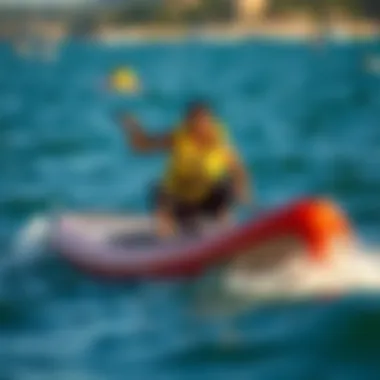
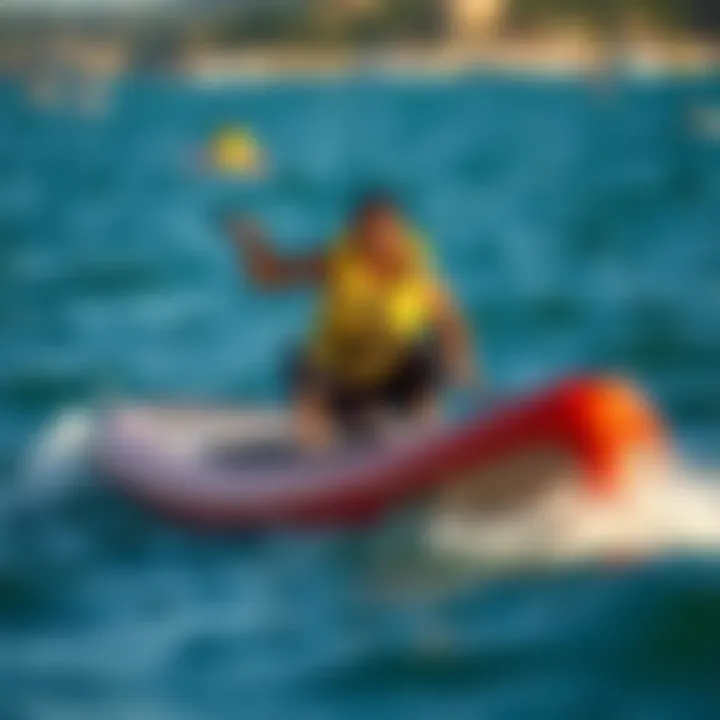
Intro
Wind stand-up paddleboarding (SUP) is a compelling fusion of traditional paddleboarding and wind sports, creating a dynamic experience on water. For both beginners and seasoned riders, understanding the nuances of this sport can transform your time on the water significantly. Navigating the interplay between wind and water involves not only one’s skill but also the right equipment.
Moreover, it’s essential to consider safety measures and the environmental impact of this sport. Such considerations can enhance both enjoyment and sustainability, ensuring that paddlers contribute to the health of our natural waterways. This guide aims to equip you with the knowledge needed to dive deeper into the world of wind SUP, discussing gear selection, skill development, and choosing optimal locations for your adventures.
Gear Selection
When it comes to wind SUP, selecting the right equipment can make a world of difference in your experience. Not only do you need a solid understanding of the various components involved, but you also have to ensure that your gear aligns with the conditions you anticipate encountering on the water.
Types of Kites
Kite choice is critical, as different types suit different conditions and skill levels. Here are some important considerations:
- Foil Kites: Excellent for light winds, they allow for easy relaunching. Their unique shape helps maintain stability.
- LEI (Leading Edge Inflatable) Kites: Best suited for those who ride in stronger winds. These kites offer superior performance and responsiveness, though they can be challenging to handle for beginners.
- Hybrid Kites: These combine features from both foil and LEI kites, offering a balance of ease and performance.
Understanding the wind conditions where you’ll be paddling can inform your kite choice. For instance, a light breeze may favor a foil kite, while stronger gusts might necessitate an LEI kite for better control.
Choosing the Right Board
The selection of your SUP board hinges on your experience level, intended use, and environmental factors. Here’s what to keep in mind:
- Volume and Size: A larger board is more stable, offering better buoyancy. As skills improve, switching to a narrower board can enhance maneuverability.
- Shape and Design: Rounded noses are great for choppy waters, while pointed noses slice through water better, enhancing speed.
- Material: Boards come in various materials like fiberglass, epoxy, or inflatable designs. Each has its unique benefits and trade-offs regarding weight, durability, and portability.
Ultimately, the right combination of kite and board will maximize your time on the water, allowing you to enjoy the winds while maneuvering confidently.
Skill Development
Once you’ve nailed down the basics of gear, it’s time to focus on your technique. Mastering wind SUP requires dedication to refine your skills, as this sport is as much about finesse as it is about strength.
Essential Techniques
- Paddling: Using proper paddle strokes is crucial for maintaining speed and steering effectively. Ensure that your strokes are consistent and engage your core for maximum power.
- Controlling the Kite: Understanding how to manipulate the kite’s position in the wind will significantly affect your speed and direction. Practice tilting the kite forward and backward to generate power.
- Transitions: Learning to transition smoothly between maneuvers can elevate your riding. Focus on shifting your weight and keeping your actions fluid to maintain balance.
Progression Tips
- Practice Regularly: Like any skill, practice makes perfect. Make it a habit to spend time on the water, familiarizing yourself with the wind dynamics.
- Take Lessons: Whether you’re a new paddler or an experienced kiteboarder, investing in a few lessons can help speed up your learning process. Instructors provide invaluable insights tailored to your individual needs.
- Join a Community: Engaging with other enthusiasts can help you gain tips and feedback while keeping you motivated. Explore forums or local meetups to find other wind SUP riders.
"The wind doesn’t dictate how hard you work; it’s about how well you adjust to its changes."
As you progress, remain mindful of the environment around you. Pay attention to safety considerations, always respect local regulations, and consider how your activities impact ecosystems. By understanding and embracing these elements, wind SUP can be a source of joy and respe ct for nature.
In closing, wind stand-up paddleboarding is more than just a hobby; it's a lifestyle choice that caters to thrill-seekers and nature lovers alike. As you paddle through the waves, you will learn to engage with the wind, mastering a dance between nature and your own skill.
Prelude to Wind SUP
Wind SUP, or wind stand-up paddleboarding, merges the serene art of paddling with the thrill of windsurfing. It's not just about being on water with a board; it's an experience, a lifestyle that captures a unique balance between mastery and leisure.
This article aims to explore the various facets of Wind SUP, from its conceptual roots to advanced techniques that seasoned riders embody. For newcomers or seasoned enthusiasts alike, understanding the intricacies and nuances of Wind SUP can significantly enhance the enjoyment and efficacy of this sport.
Definition of Wind SUP
At its core, Wind SUP combines the principles of stand-up paddleboarding with the dynamics of wind power. Riders utilize a sail to catch the wind while standing on a stable paddleboard, allowing for movement across the water with ease and agility. Unlike traditional SUP, where the paddler solely relies on their own power, Wind SUP introduces a new layer of strategy in harnessing nature's elements. With this definition, Wind SUP serves as an intersection of skill sets—balancing paddling techniques with wind management.
Historical Background
Wind SUP is a relatively new sport, emerging around the turn of the century as paddleboarding gained popularity. Roots can be traced back to the islands of Hawaii where local surfers began experimenting with adding sails to their boards, seeing potential in the wind to augment their rides. Over the years, improvements in technology and design have revolutionized equipment, making it more accessible. Significant milestones include the introduction of lighter materials and the evolution of sail designs, allowing for a broader range of riders to engage with this sport. As interest grew, so too did the communal aspect of Wind SUP, with local groups forming to share experiences and techniques.
Significance of the Sport
Wind SUP holds considerable significance for multiple reasons. For one, it opens the door to adaptability on water. Those who may find traditional paddleboarding challenging can find a renewed sense of confidence harnessing the wind. Moreover, the sport fosters community, encouraging people to come together whether on a sunny beach or a quiet lake. Events such as local competitions and casual meetups not only enhance skills but also help build friendships. The sport’s environmental aspect should not be overlooked either; engaging with the water through Wind SUP creates a connection to nature, prompting a growing awareness of ecological and conservation efforts.
"Wind SUP offers not just physical enjoyment, but also a pathway to appreciating the natural world around us."
In summary, the introduction to Wind SUP lays the groundwork for exploring all that this sport encompasses, from essential equipment to environmental considerations.
Essential Equipment for Wind SUP
When it comes to Wind SUP, having the right equipment can make or break your experience on the water. Choosing the right gear is instrumental not only for performance but also for safety and enjoyment. From the boards that glide under your feet to the sails that catch the wind, every piece of equipment plays a vital role in your adventure. Let's take a close look at the essentials.
Types of Boards
The selection of a board for Wind SUP is primarily dictated by the conditions you expect to encounter. Boards vary in shape, size, and construction, each serving a unique purpose. Here’s a breakdown of some common types:
- Freeride Boards: Perfect for those who want to explore multiple conditions without fuss. Their versatility means they perform well in both flat water and windier conditions. They typically have a wider stance for stability.
- Wave Boards: Tailored for those who plan to ride in coastal areas with waves. These boards are shorter and more maneuverable, allowing for sharper turns and adjustments.
- Race Boards: If speed is your game, a race board is what you need. These are long and thin, designed for flat water racing. They require a certain level of expertise to balance on due to their narrow build.
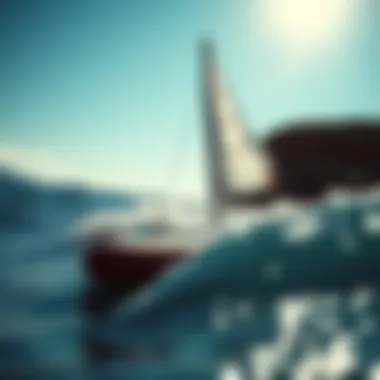
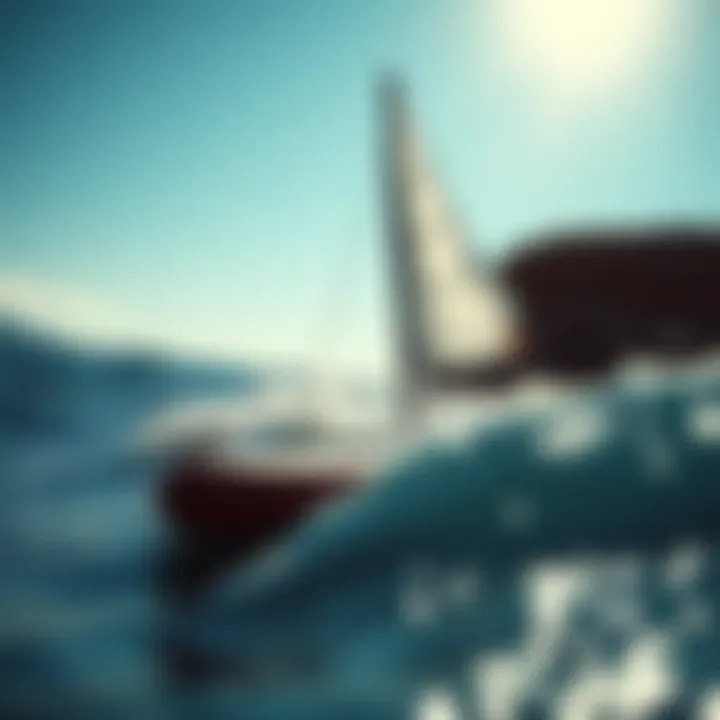
The craftsmanship of these boards varies significantly. For example, an inflatable SUP board offers portability, while a hard board provides superior performance. Selecting what works best for you is key.
Paddles and Their Importance
Never underestimate the value of a good paddle. Your paddle is your connection to the water, and choosing the right one can enhance your effectiveness in propelling forward. Here are the core factors to consider:
- Length: Depending on your height, a paddle should typically reach about 6 to 8 inches above your head when standing upright.
- Material: Paddles are commonly made from plastic, fiberglass, or carbon fiber. Plastic is heavier but cost-effective. On the other hand, carbon fiber is lightweight and durable, suitable for serious enthusiasts.
- Blade Shape: Wider blades provide more power but can be tiring for longer rides, while narrower blades are efficient for maintaining speed.
An appropriate paddle complements your style and enhances your endurance. Some paddles even come with adjustable lengths, which is a feature worth considering.
Wind Sail Selection
Selecting the right sail is crucial. The sail is your engine, driving you forward on the water. Here’s how to pick the right one:
- Size: The size of the sail directly affects how much wind it can catch. Bigger sails are beneficial in lighter winds, while smaller sails shine when the wind picks up.
- Material: Like with paddles, sails come in various materials. Dacron is common for recreational use, while mylar or sailcloth are preferred for competitive sailing due to their durability and performance.
- Type: There are different types of sails, such as camber induced or freeride designs. Camber sails deliver more power and control, while freeride sails are easier to maneuver, making them great for less experienced riders.
Choosing the right sail is crucial to harnessing the wind effectively.
In sum, equipping yourself properly for Wind SUP ensures that you enjoy every moment on the water. From understanding the types of boards available to knowing what to look for in paddles and sails, taking care to select the right equipment dramatically uplifts your Wind SUP experience.
Techniques and Skills
Understanding the nuances of techniques and skills in wind SUP is critical for anyone looking to enjoy this sport to the fullest. Mastery over these skills not only enhances performance but also ensures safety while navigating various wind and water conditions. This section sheds light on three vital aspects: balancing on the board, paddling techniques, and harnessing wind power.
Balancing on the Board
The fundamental base of wind stand-up paddleboarding lies in balance. Whether you’re paddling on calm waters or confronting choppy conditions, finding stability is essential. A solid stance can help absorb the movement of the board on the water. Feet shoulder-width apart and knees slightly bent forms a strong foundation. Staying relaxed rather than rigid allows you to respond quickly to the shifts around you.
Moreover, understand that distributing your weight correctly can drastically influence your board's behavior. Leaning too far forward can cause the nose to dig in, while leaning back may result in losing speed and control. Practice shifting your weight from heel to toe and side to side to find your balance. It could be beneficial to start in calm waters before moving to more challenging conditions.
"Balance is not something you find; it's something you create."
Be sure to have control of your core muscles; a strong center provides stability and can prevent falls. Nodules for practice might include maintaining balance while keeping one foot elevated or adjusting your stance as you begin to turn, essential when pursuing speed in wind SUP.
Paddling Techniques
Paddling in wind SUP is crucial, primarily for maneuverability and maintaining speed. A common pitfall for beginners is focusing solely on the strokes without understanding the full motion involved. An effective paddle technique combines strength with timing. One common method is the "long stroke", which extends the paddle blade far into the water, maximizing every stroke while keeping the center of gravity low.
Another aspect to consider is the angle of the paddle blade. Keeping it perpendicular to the water allows for a powerful push. If angled improperly, it decreases efficiency and can lead to fatigue. Engage your core to drive the paddle through the water instead of only using your arms. Rotating your torso adds greater power to each stroke and can conserve energy too, making your time on the board more enjoyable.
Practice different paddling styles in various conditions. Switching between forward strokes, sweep strokes for turning, and reverse strokes can significantly improve your skills as you navigate the water.
Harnessing Wind Power
Wind power is the heartbeat of wind SUP, allowing riders to navigate with grace and speed. Understanding how to read wind patterns and using this knowledge effectively can take your experience from local lakes to open oceans.
First, recognize the wind direction relative to your position. The "windward" side, or the direction the wind is coming from, is essential to comprehend for safe riding. To harness the wind optimally, angle your sail relative to the wind. The ideal position allows you to let the wind fill the sail, propelling your forward effortlessly.
Adjust your sail constantly while riding. If you are going too fast, you might ease the tension on the line to decrease sail area. Conversely, if you need more speed or control, pull in the sail tighter. This requires practice and patience. Keep an eye on the wind during your sessions; noticing shifts helps in adapting your technique, ensuring you remain propelled without losing stability.
In summary, honing your techniques and skills in wind SUP enables you to navigate diverse conditions effectively while enhancing the overall enjoyment of the sport. Practicing these elements will not just boost your confidence but can also enhance your safety on the water.
For further resources about wind SUP techniques, you can visit Wikipedia or Britannica. To connect with fellow enthusiasts, consider joining communities on Reddit or engaging with groups on Facebook.
Dive into these techniques and watch your wind SUP adventures flourish.
Safety Considerations
Understanding safety in wind SUP is paramount. This sport, while exhilarating, presents unique challenges that can’t be overlooked. Balancing on a board propelled by wind requires vigilance and awareness of surroundings. Whether you’re just starting or have clocked in many hours on the water, understanding safety is a continuous responsibility. Diving into this section will shed light on essential safety elements to ensure you can enjoy your time on the water without mishap.
Understanding Wind Conditions
Wind conditions play a crucial role in ensuring a safe and enjoyable experience on the water. Winds can shift unexpectedly, and understanding these patterns can make the difference between a smooth ride and a dangerous situation.
To master this aspect, it’s wise to check local forecasts. This includes not just the wind speed but also the wind direction. For example, offshore winds can seem inviting but can create hazards like drifting away from the shore. On the other hand, onshore winds may not only be easier but safer to navigate.
Here are some tips to gauge wind conditions:
- Local Resources: Use apps like Windy or anemometers if you have access, to measure wind speeds before heading out.
- Look for Signs: Observe trees or water surface conditions; still water means negligible wind and choppy waters could signal stronger winds.
- Be Prepared: Carrying a wind gauge can help you make informed choices, especially in areas known for unpredictable conditions.
Remember, if the wind is howling, it’s often best to pack it in for the day.
Personal Safety Gear
Having the right personal safety gear can significantly reduce risks while enjoying wind SUP. This isn't just about looking good; it's about ensuring you're protected against unexpected events. Here's a rundown of what to consider:
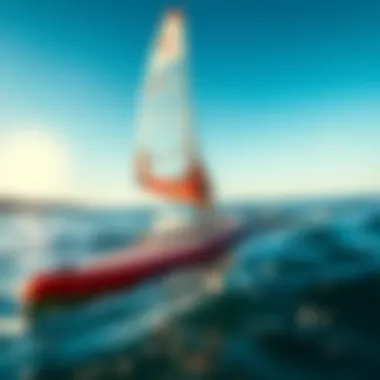
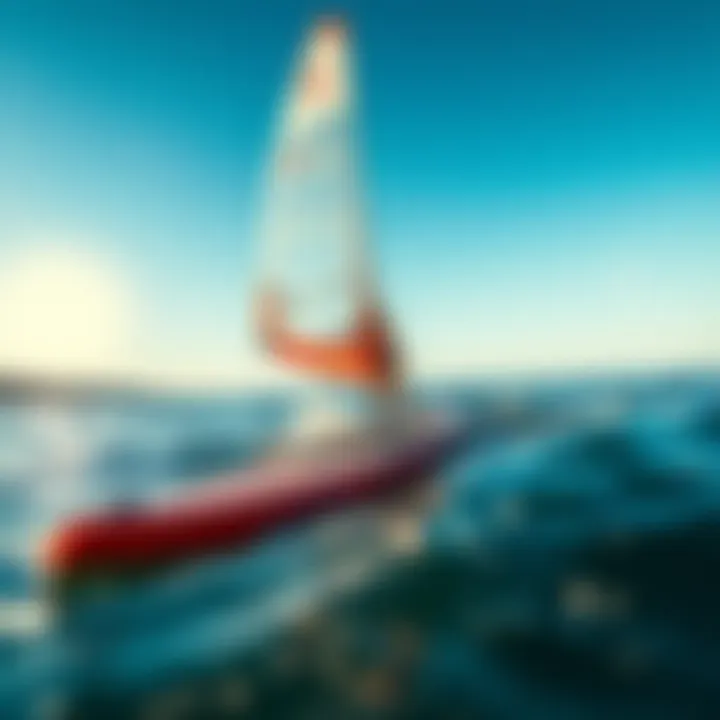
- Personal Floatation Devices (PFDs): Always wear a PFD that is Coast Guard approved. These come in various styles, including vests and jackets. Choose one that allows you to paddle and move freely.
- Leashes: Use a leash to secure your board to your body. This is especially important when winds pick up, ensuring that your board doesn’t drift away, leaving you stranded.
- Wet or Dry Suits: Depending on the water temperature, wearing appropriate suits can prevent hypothermia if you fall in. Check if you should wear a full suit or a shorty, based on conditions.
- Footwear: Durable water shoes or sandals can protect your feet from sharp rocks or barnacles, especially when embarking or disembarking.
Staying safe means being adequately geared up before hitting the waves.
Emergency Procedures
Accidents happen, and knowing what to do can save lives. Developing a clear emergency plan makes a world of difference. Here’s how to prepare for unforeseen circumstances:
- Inform Familiar Faces: Always tell someone where you are heading and the expected timeframe. Communication is key.
- Know Your Signals: Establish hand signals or have whistle signals if you’re with a group so everyone understands if someone is in distress.
- Practice Drill: Regularly rehearse what to do in case of capsizing and losing your board. Being aware of rescue techniques can save valuable time.
- First Aid Kit: Carry a small waterproof first aid kit onboard. This should have basic supplies for cuts, scrapes, or any unexpected injuries.
Environmental Impact of Wind SUP
Understanding the ecological footprint of any sport is crucial, especially in a world increasingly focused on sustainability. Wind SUP, or wind stand-up paddleboarding, is no different. As paddlers venture into nature, they not only enjoy the beauty of water and land but also hold potential responsibility for that very environment. This section delves into the environmental impact of wind SUP, highlighting essential elements that demand attention from both participants and organizers. Not only can wind SUP be a thrilling adventure, but, when practiced mindfully, it can also be a champion for environmental stewardship.
Sustainable Practices
Sustainable sailing on water begins with simple, conscientious choices. For wind SUP enthusiasts, sustainable practices can make a world of difference. It is important to choose eco-friendly equipment whenever possible. Boards made from natural or recycled materials reduce reliance on plastics that often end up polluting oceans. Moreover, actively supporting brands that prioritize sustainability is prudent.
As paddlers, each one can adopt practices like:
- Minimizing Waste: Bring reusable bottles instead of single-use plastic. Use eco-friendly snacks and cleanup your mess after a session.
- Selecting Local Launch Sites: Launching from designated areas prevents damage to local flora and fauna. Hitting the water close to populated areas reduces the strain on natural habitats too.
- Participating in Clean-up Efforts: Joining or organizing community clean-ups not only helps maintain the beauty of water bodies but also heightens awareness about pollution.
The sensitivity of aquatic ecosystems makes it crucial for wind SUP participants to tread lightly. By prioritizing eco-conscious practices, there is potential for these adventurers to protect rather than harm the environment they enjoy so much.
Wildlife Considerations
Exploring waterways often brings riders into close contact with wildlife. While the thrill of spotting a majestic sea turtle or a colony of playful seals can provide joy, paddlers must be aware that their presence can disrupt these creatures. For example, many nesting birds along shorelines might feel threatened by the activity on the water.
Best practices to mitigate impact include:
- Keeping Distance: Observing wildlife from a safe distance is key. If creatures are visibly agitated, it’s best to change course.
- Avoiding Areas During Breeding Seasons: Some species have specific breeding seasons during which they require undisturbed habitats.
- Using Quiet Gear: Selecting quieter equipment can also help to minimize disturbance to local animals. This is especially important in sensitive areas.
Community education is equally vital. By promoting awareness about local wildlife behaviors and needs, all who partake in wind SUP can better coexist with the natural world.
Impact on Water Quality
The relationship between wind SUP and water quality is often overlooked. Paddlers have the potential to contribute to pollution if they don’t practice proper management of waste and gear. Simple actions, such as ensuring that chemical residues from sunscreen or other products don’t wash off into the water, can play a part in maintaining cleaner habitats.
Some considerations for maintaining water quality include:
- Using Biodegradable Products: Invest in biodegradable sunscreens and personal care products to ensure that harmful chemicals don't seep into the environment.
- Educating Others: As seasoned enthusiasts educate newcomers on the importance of keeping water clean, the culture of awareness grows.
- Checking Equipment for Maintenance: Making sure that boards and sails don’t have leaks prevents unwanted materials from entering the water.
By being responsible stewards of the water, wind SUP participants can significantly lessen their environmental impact, thus enhancing their experience while safeguarding nature for future generations.
The ripple effect of small, thoughtful actions can lead to profound changes. Wind SUP provides the tools and the opportunity to not only enjoy water but also to protect it. By integrating these considerations into planning and practice, participants can contribute to a sustainable relationship with the environment.
For more insights on environmental conservation, you might find this page from National Park Service helpful. For damages relating to wildlife, consider visiting National Wildlife Federation.
Best Locations for Wind SUP
Finding the right place to practice wind stand-up paddleboarding (SUP) can make or break the experience. Not only do locations influence the quality of the wind and water conditions, but they also offer various amenities and learning opportunities. The ideal spots for wind SUP cater to different skill levels and preferences. As both an exhilarating and demanding sport, the surroundings play a crucial role in enhancing the enjoyment and providing a safe environment. So whether it’s the bracing saltwater of the coast, the calmness of a lake, or the thrill of an international hotspot, doing your homework about the best locations will set you on a course for memorable adventures on the water.
Coastal Areas
Coastal regions often top the list for wind SUP adventures. The combination of consistent wind patterns and wave action can make a great playground for paddleboard enthusiasts. Beaches like Huntington Beach in California and Maui's Kite Beach provide perfect wind conditions, making them sought-after destinations.
The benefits of coastal locations include:
- Reliable Wind: Coastal areas typically experience steady winds, ideal for riders who are looking to hone their skills.
- Wave Variety: Riders can choose to paddle in flat water or take on challenging waves, depending on their confidence and skill level.
- Amenities: Many beaches offer rentals, lessons, and safety equipment, perfect for beginners or those traveling.
However, it's vital to be mindful of local conditions and peak times. Areas can get crowded, and varying tide levels can change water safety. Familiarizing yourself with local regulations is crucial.
"When you know the spot like the back of your hand, you turn an average ride into a thrilling adventure."
Lakes and Rivers
Lakes and rivers present another terrific setting for wind SUP, especially for those who prefer calmer environments. Such spots often lack the intense waves found at the coast but provide relatively smooth paddling surfaces that can be great for beginners learning the ropes. Popular locations like Lake Tahoe in California or the Thames River in London show how versatile these places can be.
Here are some key considerations:
- Still Conditions: Lakes often have lighter winds that can change quickly. This factor should be taken into account when planning a trip.
- Scenic Routes: Paddling on rivers and lakes offers beautiful landscapes and opportunities to connect with nature, providing a serene backdrop for your experience.
- Safety: These environments can be shallower, so it’s crucial to keep aware of hidden obstacles beneath the surface.
International Destinations
For those looking to add a bit of adventure to their wind SUP experience, international destinations provide thrilling opportunities. Countries like Spain, Brazil, and Thailand are becoming hotspots for water sports enthusiasts because of their warm climate and excellent wind conditions. Locations such as Tarifa in Spain and the Campeche coast in Mexico not only offer great wind but also local cultures that are enriched by watersports.
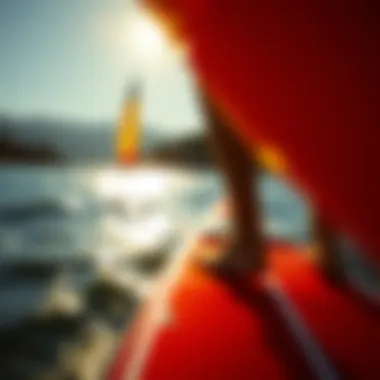
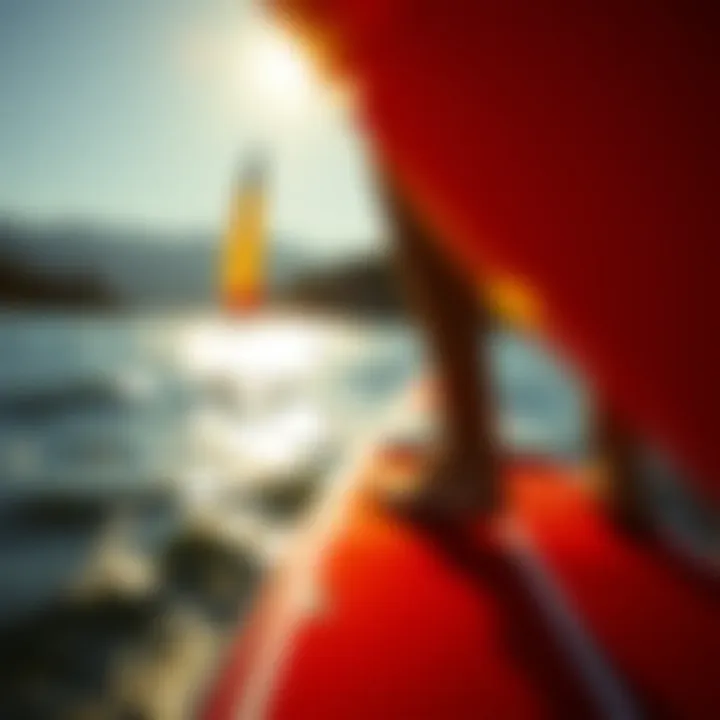
Consider the following when traveling abroad to wind SUP:
- Cultural Experience: Different countries embody unique styles and practices in wind SUP, providing a chance to learn from local experts.
- Seasonal Wind: Some areas have specific seasons where conditions are generally favorable, so planning your trip around this is wise.
- Learning Opportunities: Many international hubs offer vacation packages with training courses, gear rentals, and group excursions, perfect for both seasoned paddlers and novices.
Keeping in mind the various geographical and cultural aspects of wind SUP can invigorate your paddling journey, allowing for an enriching, satisfying experience on the water.
Community and Events
The world of wind stand-up paddleboarding (SUP) isn't just about the rush of the wind against your face or the serenity of gliding across reflective waters; it's also about the vibrant community that surrounds the sport. Engaging with fellow enthusiasts can elevate your experience, providing support, sharing knowledge, and enhancing the joy of the sport significantly.
Clubs and Organizations
Joining a club or an organization is one of the best ways to immerse yourself in the wind SUP community. These groups not only bring together individuals with a shared passion but also offer structured learning and social opportunities. Many localized clubs arrange meetups, training sessions, and social outings, fostering a sense of camaraderie.
Often, these organizations provide resources like access to equipment, workshops on techniques, and safety protocols. Being part of a community also means gaining insights into the best local spots for paddling, thanks to the invaluable shared experiences of members. In addition to practical benefits, clubs often promote a healthy competition that can inspire both novice and experienced paddlers.
- Key Benefits:
- Access to expert advice and mentorship
- Regular social events that build friendships
- Opportunities for cooperative learning and skill development
Competitions and Tournaments
Competitions and tournaments play a pivotal role in invigorating the wind SUP scene. They bring forward not only athletes but also spectators who share a love for the sport. Participation in these events provides paddlers with a chance to challenge their skills and push their limits, making personal achievements feel even more rewarding.
Events range from local races to international championships, offering various formats that cater to different skill levels. Competing often leads to valuable networking opportunities, allowing you to connect with industry professionals, sponsors, and fellow athletes. Plus, tournaments frequently include workshops or clinics led by seasoned riders, enhancing the learning experience.
"Competing is as much about the thrill of the sport as it is about making connections that last a lifetime."
Networking Opportunities
Networking within the wind SUP community is essential for personal growth and development in the sport. The connections made can lead to job opportunities, collaborations, partnerships, or even friendships that extend beyond the water. There are numerous ways to build your network, from attending events and workshops to participating in online forums and social media groups.
- Recommended Platforms:
- Facebook groups focused on wind SUP
- Reddit forums for discussions and advice
- Local meetups listed on platforms like Meetup.com
Applying the connections you make to real-world scenarios—be it organizing a paddle trip or launching a new product line—can propel both your personal journey and the community's growth. Each connection, small or large, can add immense value to your experience in the wind SUP world.
The Future of Wind SUP
The future of wind stand-up paddleboarding, often abbreviated as Wind SUP, holds promise that goes well beyond just being a trendy water sport. As various factors intertwine, such as innovation, market dynamics, and cultural evolution, the landscape for Wind SUP is on the brink of significant transformation. It is essential to understand how these elements can enhance enthusiasts’ experiences and what considerations they might entail.
Technological Advancements
In recent years, technological advancements have begun reshaping the ways people engage with water sports, and Wind SUP is no exception. Innovations in materials and design, for instance, have led to lighter and more durable boards, enhancing maneuverability on the water. Paddles have also improved, with adjustments in materials that allow for better grip and control, making it easier for both novices and seasoned paddlers to embark on unique adventures.
Moreover, the integration of smart technology cannot be overlooked. Wearable devices can track paddling speed, wind conditions, and even the rider's heart rate, allowing for a data-driven approach to performance improvement. Riders now have easy access to apps that provide real-time updates on wind strength and direction, which can be a game-changer for planning outings. The a(b)ility to harness this information can lead to safer and more enjoyable experiences.
Market Trends
From a market perspective, Wind SUP is witnessing a gradual but growing acceptance within mainstream watersports. This shift translates to broader availability of equipment and rental services in various locales, promoting inclusivity and increasing participation. As the trend continues, entry-level boards and affordable paddles are becoming more accessible, removing financial barriers for potential newcomers.
Furthermore, collaboration between brands and sports associations has led to a surge in organized events and tournaments. These gatherings not only foster community but also raise awareness for the sport, appealing to both participants and spectators. With more competitions on the horizon, there is an expectation of increased sponsorship, thereby providing financial growth opportunities within the sector.
Cultural Shifts in Watersports
As attitudes and lifestyles evolve, so too does the culture surrounding watersports. The inclination toward environmentally-friendly practices has instigated a ripple effect in Wind SUP. A growing number of riders are becoming more conscious of their ecological impact, and many brands are responding by producing eco-friendly equipment that reduces waste and embraces sustainability.
Moreover, increased media coverage and the rise of social platforms have created a vibrant community where enthusiasts can share experiences and learn from one another. A focus on inclusivity is also on the rise; adaptive Wind SUP initiatives are emerging, allowing people with disabilities to advance in this exhilarating sport.
In summary, the landscape of Wind SUP is set for an exciting journey. As technological advancements, evolving market trends, and cultural shifts converge, enthusiasts can expect richer experiences and broader accessibility in the years to come.
Ending
The conclusion of any guide serves as a crucial anchor, synthesizing the tapestry of knowledge that has been spun throughout. For wind stand-up paddleboarding (SUP), it’s more than just a summary; it is a call to action and reflection. As we’ve explored the diverse dimensions of this sport, it becomes clear that the beauty of wind SUP lies in its dynamic blend of skill, strategy, and environmental awareness.
Summarizing Key Points
Wind SUP is not simply about paddling on water with the wind at your back; it's about mastering several key components:
- Equipment: Understanding the right boards, paddles, and sails is fundamental. Each piece has its place, and knowing what works best can drastically affect your performance.
- Techniques: The art of balancing and leveraging wind power requires practice and patience. These techniques not only increase enjoyment but also enhance safety on the water.
- Safety Considerations: Being attuned to wind conditions, having the right gear, and knowing emergency procedures cannot be emphasized enough. All these factors play into creating a safer experience.
- Environmental Awareness: An understanding of how our activities impact the ecosystem and committing to sustainable practices ensure that wind SUP remains a viable option for future generations.
- Community Engagement: Joining clubs, participating in events, and networking enrich the sport, providing support and shared experiences that can deepen one’s love for wind SUP.
Each of these points builds the framework for not just enjoying wind SUP but thriving within its community and upholding its values. "The experience on the water teaches you not just about the sport, but about respecting nature," echoes a seasoned paddler.
Encouragement to Explore Wind SUP
With the foundations laid in this guide, one can’t help but feel that the world of wind SUP is ripe for exploration. Whether you're a novice eager to dip your toes in or a seasoned rider looking to refine your technique, the water awaits.
Finding the right location to practice, choosing the right gear, and committing to continual learning will undoubtedly heighten your experience. Many enthusiasts find joy in the unique thrill of harnessing the wind, while others cherish the serene moments spent gliding across the water.
"Every stroke on the paddle opens the door to adventure, challenge, and self-discovery."
— An avid wind SUP rider
As you step onto your board, remember that each moment on the water is an invitation to connect with the elements, expand your skills, and deepen your appreciation for this exhilarating sport. The future of wind SUP is bright, and your journey begins with that first breeze at your back.















